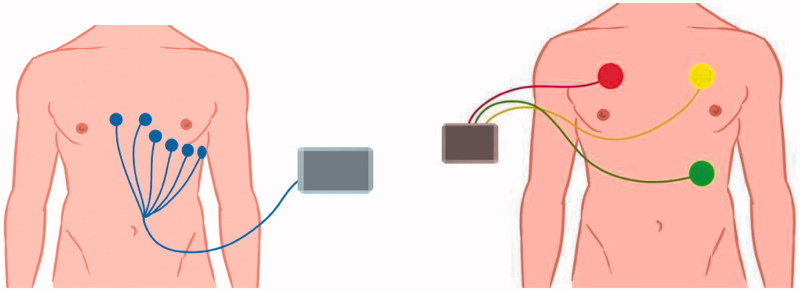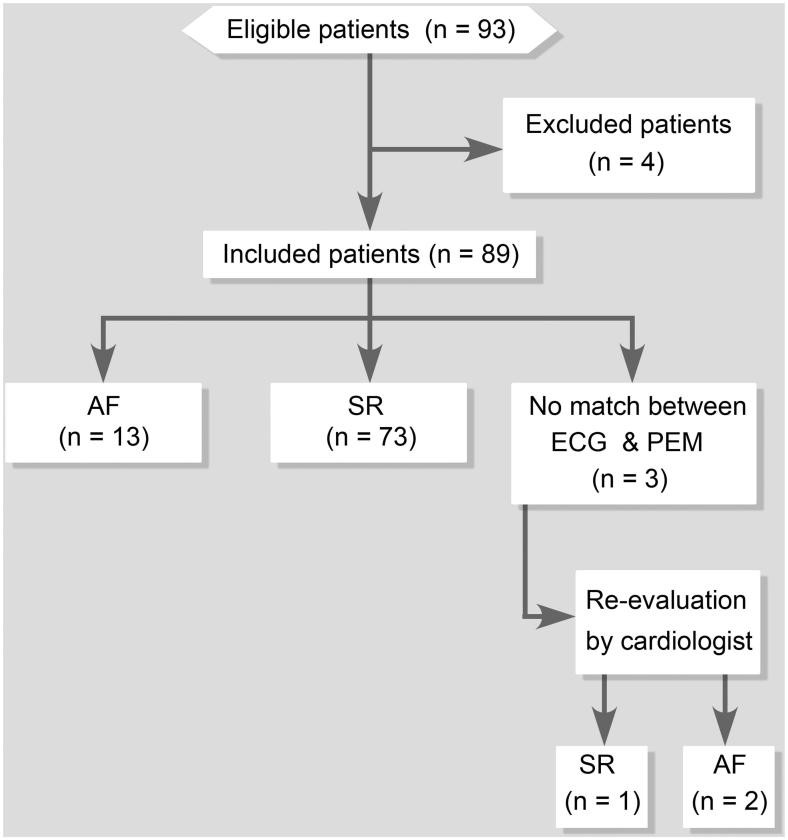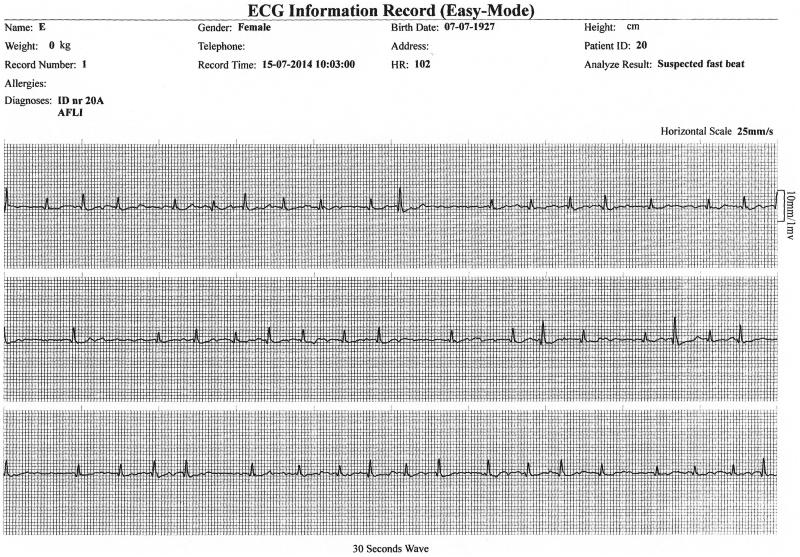Abstract
Objective
To evaluate how well an inexpensive portable three-lead ECG monitor PEM identified patients with atrial fibrillation (AF) compared to a normal 12-lead ECG.
Design
Cross-sectional method comparison study.
Setting
From April 2014 to February 2015, we included patients coming to the general practice clinic “Lægerne Sløjfen”, Aalborg, Denmark for a routine ECG. Patients with severe dementia, mental illness or poor ECG readings were excluded. After oral and written informed consent an ECG and PEM recordings were obtained simultaneously. The PEM recordings were analyzed by two general practitioners (GPs) in training and ECG recordings were evaluated by a senior GP and a cardiologist. Both the PEM and the ECG recordings were analysed blinded.
Subjects
Ninety-three patients were included and four were excluded due to poor ECG readings.
Main outcome measures
The sensitivity and specificity of PEM compared to a standard 12-lead ECG.
Results
Eighty-nine of the 93 (95.7%) patients had ECGs of a satisfactory technical quality and were included in the study. The sensitivity of diagnosing AF by PEM recordings was 86.7% and the specificity was 98.7% when compared to a 12-lead ECG. According to the cardiologist, the misclassification of three PEM recordings were due to interpretation errors and not related to the PEM recording per se.
Conclusions
The inexpensive portable PEM device recording diagnosed AF with a high sensitivity and specificity.
Key Points
Simple ECG monitors could be useful to identify atrial fibrillation and thereby lead to a better prevention of stroke.
The PEM device was easy to use and 95.7% of the recordings were technically acceptable for detecting atrial fibrillation.
The PEM device has a high sensitivity and specificity in detecting atrial fibrillation compared to a standard 12-lead ECG.
Further studies should evaluate the clinical usefulness of the PEM device, e.g. to detect intermittent atrial fibrillation.
Keywords: Ambulatory, atrial fibrillation, electrocardiography, family practice, general practice, Denmark
Background
Atrial fibrillation (AF) increases the risk of cardiac emboli and ischemic stroke and is the most common arrhythmia among elderly citizens.[1] A heart rhythm recording (ECG, Holter or telemetry monitoring) is mandatory for diagnosing AF. Performing a 12-lead ECG is easily done in mobile patients who are able to attend a consultation at general practice clinic or hospital outpatient clinic. However, patients who are immobile or have other conditions, e.g. social anxiety are confined to their homes. Hence, it may be necessary to make a recording of their cardiac rhythm at home. Furthermore, intermittent arrhythmia may either be detected by using long lasting continuous (Holter monitor) or short repeated assessments using a portable three-lead ECG monitor (PEM). In a recent study that compared a portable recording device with a short-term 24 h continuous Holter ECG found that the PEM device used to detect AF in patients with prior stroke was more cost-effective.[2] Hopefully, a reasonably priced and easy-to-use PEM device could be used to facilitate a swift diagnosis of AF in a general practice setting.
The aim of this study was to evaluate the proportion of technically acceptable PEM recordings as well as the sensitivity and specificity in relation to detecting AF using a PEM device compared with a standard 12-lead ECG in a general practice population.
Methods
From April 2014 to February 2015 patients from the GP clinic “Lægerne Sløjfen” in Aalborg, Denmark, who performed a routine 12-lead ECG were invited to participate. The invited patients either had known paroxysmal AF or were invited among patients who came for an annual routine health check. We aimed to include 30–50% with a diagnosis of AF and 50–70% without AF. Patients with severe dementia, mental illness or poor ECG readings were excluded. Oral and written informed consent was given by all participants.
A 30 s three-lead recording using a PEM device (Portable ECG Monitor, Beijing Choice Electronic Technology Co., Ltd., Beijing, China) and simultaneously, a standard 10 s 12-lead ECG recording (Cardiax PC-ECG, Mesa, Benediktbeuern, Germany) were obtained. Figure 1 depicts the placement of the electrodes.
Figure 1.
The placement of the ECG and PEM electrodes.
The PEM is capable of storing the data/ECG. The ECGs were transferred from the PEM to a personal computer and were evaluated after printing. The PEM recordings were analyzed by two GP trainees (ANK & BJ) who were blinded for the results of the ECG recordings as well as for the patients’ characteristics except for gender and age. Blinded to the PEM registrations the ECG recordings were evaluated by a senior GP (MBJ) and a cardiologist specialized in Electrophysiology (SR). Another cardiologist settled any disagreement over evaluation. After finishing the blinded analysis the investigators obtained information from patient medical records on relevant rhythm-controlling medication and diagnosis to determine study population demographics.
Diagnosing AF from the PEM recordings
We defined AF as irregular supraventricular arrhythmia without p-waves at the baseline.
Statistics
The patient flow is described according to the STARD statement.[3] Those being PEM AF positive and ECG AF positive are true positive (TP) and those PEM AF negative and ECG AF negative are true negative (TN). A PEM AF positive, but ECG AF negative is false positive (FP), and PEM AF negative, but ECG AF positive is false negative (FN).[4] The prevalence of AF was calculated as TP/Total Population. The true positive rate=sensitivity (%) of the PEM device for detecting AF was 100%×TP/(TP + FN). Similarly, the true negative rate=specificity (%) of the PEM device for detecting AF was calculated as: 100%×TN/(TN + FP) and the accuracy (ACC) = 100%×TP + TN/Total Population. The positive predictive value: (PPV) = TP/(TP + FP) and the negative predictive value: (NPV) = TN/(TN + FN). The false positive rate = type I error = 100%× (FP/FP + TN) and the false negative rate = type II error = 100%× (FN/TP + FN).
Results
Of 93 patients invited 89 were included in the study; four patients were excluded due to poor ECG quality (Figure 2). There was an even distribution of women and men and the most common diagnoses that the participants had were hypertension, AF, and diabetes (Table 1).
Figure 2.
Flow chart.
Table 1.
Patients characteristics.
| Total population (number) | 89 |
|---|---|
| Men (n, (%)) | 48 (54) |
| Age (mean, (range)) | 67 (18–92) |
| Ischemic heart disease (n, (%)) | 10 (11) |
| Hypertension (n, (%)) | 48 (54) |
| Diabetes (n, (%)) | 19 (21) |
| Known atrial fibrillation diagnosis (n, (%)) | 32 (36) |
| aMedication affecting the heart rhythm (n, (%)) | 42 (47) |
Beta-blockers, Ca2+ antagonist, Flecainid, Digoxin, Amiodaron.
An example of a HEM registration is given in Figure 3 showing AF.
Figure 3.
Example of a PEM recording. The figure shows the recorded results of a patient with AF. The PEM device shows the patient’s heart rate (HR) and suggests an analysis of the recording (analysis result). The remaining information including the diagnosis is provided by the operator.
Table 2 reports the number of patients classified as having AF or not based on recording by the PEM device and the ECG. Additionally, the prevalence, sensitivity, specificity, PPV, and NPV are reported. One of the PEM readings that were interpreted as AF was classified as sinus arrhythmia by the cardiologist on the ECG. Another PEM reading was interpreted as sinus tachycardia, but classified as AF by the cardiologist on the ECG. Finally, one PEM reading was interpreted as normal, but was classified as AF by the cardiologist on the ECG. A subsequent cardiologist evaluation of the three PEM recordings misclassified by the GPs in training confirmed that this was in fact also what was found on the PEM recordings. Hence, the misclassification was due to misinterpretation of the recording.
Table 2.
Classification of heart rate recordings in relation to atrial fibrillation (AF).
Results based on the 12-lead ECG.
Results based on a portable ECG monitor reviewed by two GP trainees.
The prevalence of AF calculated from the 12-lead ECG recordings: 16.9% and 15.7% based on the PEM device.
The AF diagnosis based on the PEM device recordings compared to the 12-lead ECGs (gold standard) was as follows:
Sensitivity was 86.7%.
Specificity was 98.6%.
Accuracy was 96.6%.
Positive predictive value was 86.7%.
Negative predictive value was 97.3%.
The false negative rate was 13.3%.
The false positive rate was 1.4%.
Discussion
This study showed that a small cheap PEM device had a high sensitivity and specificity for finding AF in a general practice population.
The PEM device was tested in an elderly population and many had conditions commonly seen in general practice such as hypertension and diabetes. A strength of the study was the fact that the ECG and PEM readings were evaluated in a blinded manner and the gold standard was the evaluation of the 12-lead ECG by a cardiologist specialized in arrhythmia. The cardiologist reevaluated the three PEM readings that were not interpreted as the ECG and found that they were in fact in accordance with the ECG readings. Hence, we can conclude that the misinterpretation was due to lack of experience on behalf of the GP trainees and not because of poor PEM recordings. Nevertheless, the sensitivity and specificity were very high.
Several papers describe a positive correlation between handheld ECG use and the number of patients diagnosed with AF.[5,6] However, in contrast to our study these studies compare a handheld device with a 24 h ECG monitor and the handheld devices were used intermittently.
The preliminary results of using a PEM device are very encouraging in relation to detecting AF and in this population with 16.9% having AF the PPV of a positive PEM finding was very high (92.9%). This could be even further improved by having a cardiologist evaluating the PEM recording as the experience of the physician when interpreting the PEM/ECG recordings will remain a key issue.[7] Further studies should evaluate use of the PEM device in the patients’ home and, for example, compare the PEM readings with a continuous Holter monitoring or as an event recorder.[8]
Implementation of the PEM device or other similar devices in general practice clinics and in the homes of the patients could enhance diagnosing AF leading to anticoagulation therapy in high risk patients with a view to reducing the incidence of stroke.
Conclusion
We conclude that the PEM device is well suited to detect AF in general practice population.
Acknowledgements
We thank our colleague Søren Hjortshøj M.D, Ph.D., Aalborg University Hospital for his assistance in resolving any disagreements in the evaluation of ECG results.
Ethical approval: All patients gave oral and written informed consent and the study was conducted in accordance with the Helsinki Declaration of 1975 as revised in 1983. No approval was needed according to the Regional Research Ethics Committee, but the Regional Data Protection Agency was notified of the study.
Disclosure statement
The authors declare no conflict of interest.
Funding information
The PEM device was financed by the Research Unit for General Practice in the North Denmark Region, but otherwise the project received no external funding.
References
- 1.Danish Board of Health – Specialevejledning for intern medicin: kardiologi [Internet]; [cited 2015 Apr]. Available from: http://sundhedsstyrelsen.dk/∼/media/A7313BC72CC54058A1A660AAB8CCF465.ashx. [Google Scholar]
- 2.Levin L, Husberg M, Sobocinski PD, et al. A cost-effectiveness analysis of screening for silent atrial fibrillation after ischaemic stroke. [Internet]; [cited 2015 Apr]. Available from: http://dx.doi.org/10.1093/europace/euu213 207-214. [DOI] [PubMed] [Google Scholar]
- 3.STARD Statement Standards for the reporting of diagnostic accuracy studies. [Internet]; [cited 2015 Apr]. Available from: http://stard-statement.org/. [Google Scholar]
- 4.Sensitivity and specificity [Internet]; [cited 2015 Apr]. Available from: http://en.wikipedia.org/wiki/Sensitivity_and_specificity. [Google Scholar]
- 5.Hendrikx T, Rosenqvist M, Wester P, et al. . Intermittent short ECG recording is more effective than 24-hour Holter ECG in detection of arrhythmias. BMC Cardiovasc Disord. 2014;14:41. doi: 10.1186/1471-2261-14-41. [DOI] [PMC free article] [PubMed] [Google Scholar]
- 6.Doliwa PS, Rosenqvist M, Frykman V.. Paroxysmal atrial fibrillation with silent episodes: intermittent versus continuous monitoring. Scand Cardiovasc J. 2012;46:144–148. [DOI] [PubMed] [Google Scholar]
- 7.Novotny T, Bond RR, Andrsova, et al. . Data analysis of diagnostic accuracies in 12-lead electrocardiogram interpretation by junior medical fellows. J Electrocardiol. 2015;48:988–994. [DOI] [PubMed] [Google Scholar]
- 8.Hendrikx T, Hörnsten R, Rosenqvist M, et al. . Screening for atrial fibrillation with baseline and intermittent ECG recording in an out-of-hospital population. BMC Cardiovasc Disord. 2013;13:41. doi: 10.1186/1471-2261-13-41. [DOI] [PMC free article] [PubMed] [Google Scholar]





